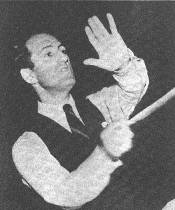George Gershwin (1898-1937)
(born Brooklyn, 26 September 1898; died Hollywood, 11 July 1937).
 Essentially
self-taught, he was first a song plugger in Tin Pan Alley and an
accompanist. In his teens he began to compose popular songs and
produced
a succession of musicals from 1919 to 1933 (Lady,
be Good!,
1924;
Oh,
Kay!, 1926; Strike up the Band, 1927; Funny Face,
1927;
Girl Crazy, 1930); the lyrics were generally by his
brother
Ira (1896 1983). In 1924 he became famous:
he wrote
"Rhapsody in Blue" as a concerto for piano and Paul
Whiteman's
jazz
band. Its success led him to devote increasing energy to
'serious'
composition. His more ambitious works include the Piano
Concerto in F (1925) and the tone
poem An American in Paris (1928).
But he contiuned composing for the musical theatre, and some of his
most
successful musicals (Strike up the Band, Girl
Crazy,
Of Thee I Sing) date from this period. In 1934-5 he wrote his
'American
folk opera' Porgy
and Bess,
which draws on African-American idioms; given on Broadway, it was only
a limited success. Gershwin went to Hollywood in
1936 and wrote songs for films. He was a sensitive songwriter of
great melodic gifts and did much to create
syntheses
between jazz and classical traditions in his concert music and
black
folk music and opera in Porgy
and Bess.
Essentially
self-taught, he was first a song plugger in Tin Pan Alley and an
accompanist. In his teens he began to compose popular songs and
produced
a succession of musicals from 1919 to 1933 (Lady,
be Good!,
1924;
Oh,
Kay!, 1926; Strike up the Band, 1927; Funny Face,
1927;
Girl Crazy, 1930); the lyrics were generally by his
brother
Ira (1896 1983). In 1924 he became famous:
he wrote
"Rhapsody in Blue" as a concerto for piano and Paul
Whiteman's
jazz
band. Its success led him to devote increasing energy to
'serious'
composition. His more ambitious works include the Piano
Concerto in F (1925) and the tone
poem An American in Paris (1928).
But he contiuned composing for the musical theatre, and some of his
most
successful musicals (Strike up the Band, Girl
Crazy,
Of Thee I Sing) date from this period. In 1934-5 he wrote his
'American
folk opera' Porgy
and Bess,
which draws on African-American idioms; given on Broadway, it was only
a limited success. Gershwin went to Hollywood in
1936 and wrote songs for films. He was a sensitive songwriter of
great melodic gifts and did much to create
syntheses
between jazz and classical traditions in his concert music and
black
folk music and opera in Porgy
and Bess.
 Essentially
self-taught, he was first a song plugger in Tin Pan Alley and an
accompanist. In his teens he began to compose popular songs and
produced
a succession of musicals from 1919 to 1933 (Lady,
be Good!,
1924;
Oh,
Kay!, 1926; Strike up the Band, 1927; Funny Face,
1927;
Girl Crazy, 1930); the lyrics were generally by his
brother
Ira (1896 1983). In 1924 he became famous:
he wrote
"Rhapsody in Blue" as a concerto for piano and Paul
Whiteman's
jazz
band. Its success led him to devote increasing energy to
'serious'
composition. His more ambitious works include the Piano
Concerto in F (1925) and the tone
poem An American in Paris (1928).
But he contiuned composing for the musical theatre, and some of his
most
successful musicals (Strike up the Band, Girl
Crazy,
Of Thee I Sing) date from this period. In 1934-5 he wrote his
'American
folk opera' Porgy
and Bess,
which draws on African-American idioms; given on Broadway, it was only
a limited success. Gershwin went to Hollywood in
1936 and wrote songs for films. He was a sensitive songwriter of
great melodic gifts and did much to create
syntheses
between jazz and classical traditions in his concert music and
black
folk music and opera in Porgy
and Bess.
Essentially
self-taught, he was first a song plugger in Tin Pan Alley and an
accompanist. In his teens he began to compose popular songs and
produced
a succession of musicals from 1919 to 1933 (Lady,
be Good!,
1924;
Oh,
Kay!, 1926; Strike up the Band, 1927; Funny Face,
1927;
Girl Crazy, 1930); the lyrics were generally by his
brother
Ira (1896 1983). In 1924 he became famous:
he wrote
"Rhapsody in Blue" as a concerto for piano and Paul
Whiteman's
jazz
band. Its success led him to devote increasing energy to
'serious'
composition. His more ambitious works include the Piano
Concerto in F (1925) and the tone
poem An American in Paris (1928).
But he contiuned composing for the musical theatre, and some of his
most
successful musicals (Strike up the Band, Girl
Crazy,
Of Thee I Sing) date from this period. In 1934-5 he wrote his
'American
folk opera' Porgy
and Bess,
which draws on African-American idioms; given on Broadway, it was only
a limited success. Gershwin went to Hollywood in
1936 and wrote songs for films. He was a sensitive songwriter of
great melodic gifts and did much to create
syntheses
between jazz and classical traditions in his concert music and
black
folk music and opera in Porgy
and Bess.